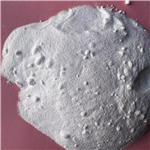Semicarbazide hydrochloride is a white crystalline solid.
Inhibitor of enzyme. Hypotensive
Semicarbazide hydrochloride is used as urease substrate and MAO inhibitor. Derivatizing agent for carbonyl compounds as their semicarbazones which produces crystalline compounds with characteristic melting points. Also used in heterocyclic synthesis. Semicarbazone formation has been used to separate carbonyl compounds from mixtures by adsorption onto silica gel from a hydrocarbon solution. Regeneration is by hydrolysis with oxalic acid.
A metabolite of Nitrofuran.
ChEBI: Semicarbazide hydrochloride is an organic molecular entity.
Toxic by ingestion. Questionable carcino-
gen.
Semicarbazide hydrochloride is a chemical reagent, and an indicator for its metabolic parent nitrofurazone, a veterinary drug that has been banned for use in livestock production in the European Union and the U.S. amongst other jurisdictions.
After Semicarbazide hydrochloride ingestion, experimental animals have developed tremors, ataxia, equilibrium difficulties, and convulsions. Its proposed mechanism of action is by binding to cytosine residues in RNA, to deoxycytosine residues in DNA and to cytosine and deoxycytosine nucleosides.
Semicarbazide hydrochloride has an oral LD50 of 225mg/kg in mice and 123 mg/kg in the rat. Some studies suggest that Semicarbazide hydrochloride is a mutagen, an animal carcinogen and a teratogen.
Due to the lack of data in humans and overall limited evidence of carcinogenicity in animals, semicarbazide hydrochloride was classified as an IARC Group 3 agent: not classifiable as to its carcinogenicity to humans. Due to its equivocal carcinogenic and mutagenic properties, when handling Semicarbazide hydrochloride and animals treated with Semicarbazide hydrochloride, it is imperative to take caution and adhere to the following guidelines to minimize exposure and the effects of exposure during normal and emergency situations.
Flammability and Explosibility
Not classified
Poison by ingestion and intraperitoneal routes. Experimental reproductive effects. Questionable carcinogen with experimental neoplastigenic and teratogenic data. Mutation data reported. When heated to decomposition it emits very toxic fumes of NOx and HCl
This material is used as a reagent for ketones and aldehydes with which it affords crystalline compounds having characteristic freezing/melting points. Also used in isolation of hormones and certain fractions from essential oils.
UN2811 Toxic solids, organic, n.o.s., Hazard Class: 6.1; Labels: 6.1-Poisonous materials, Technical Name Required.
Crystallise the salt from aqueous 75% EtOH and dry it under vacuum over CaSO4. Alternatively crystallise it from a mixture of 3.6 mole % MeOH and 6.4 mole % of water. [Kovach et al. J Am Chem Soc 107 7360 1985.] IR: 700, 3500 cm-1 [Ingersoll et al. Org Synth Coll Vol I 485 1941, Davison & Christie J Chem Soc 3389 1955, Thiele & Stange Chem Ber 27 33 1894, pK: Bartlett J Am Chem Soc 54 2853 1923]. The free base crystallises as prisms from absolute EtOH, m 96o. [Curtius & Heidenreich Chem Ber 27 55 1894, Beilstein 3 IV 177.] TOXIC ORALLY, possible CARCINOGEN and TERATOGEN.
Incompatible with oxidizers (chlorates, nitrates, peroxides, permanganates, perchlorates, chlorine, bromine, fluorine, etc.); contact may cause fires or explosions. Keep away from alkaline materials, strong bases, strong acids, oxoacids, epoxides. May ignite combustible materials (wood, oil, paper).



